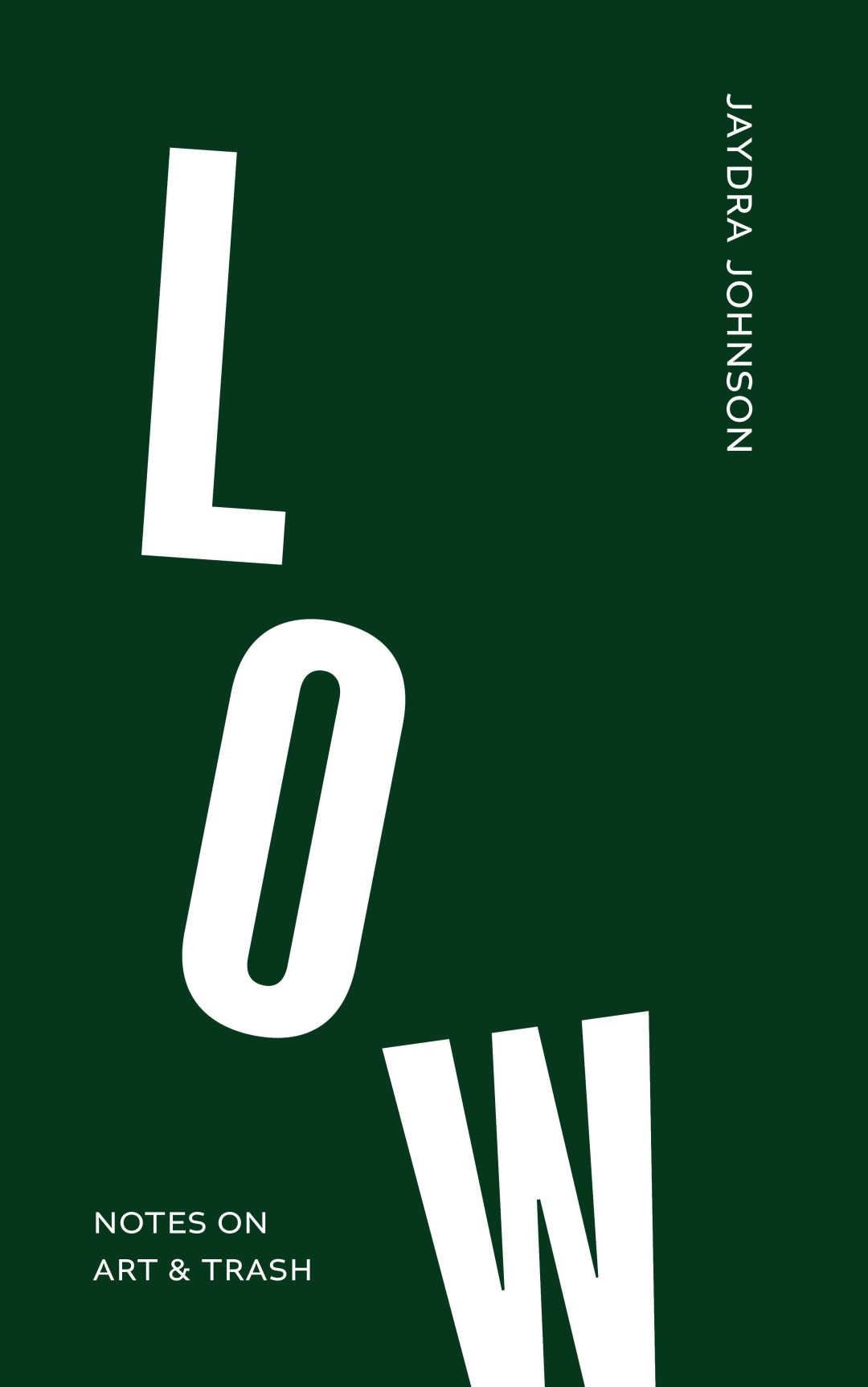A Guide to Loving Trash

Image: Courtesy Leora Fuller
Trash has always been a problem. Theoretically, you want the least amount of it possible, for climate concerns, because it’s unsightly and annoying, because it’s a waste, because it stinks. However, as Portlander Jaydra Johnson points out in a new memoir, Low: Notes on Art & Trash, garbage can be quite useful. Going back to at least Shakespeare’s day, those with the means to do so have been creating trash to lift themselves up—labeling other people trash, that is. They’ve trashed people to scapegoat murders, as Iago did in Othello (“I do suspect this trash to be a party in this injury”), but most often to create an all-purpose foil for their own nobility. As Blackness is derided to celebrate whiteness, queerness to champion heterosexuality, and femininity cast as a fragile dependence to lionize the brawny necessity of male figures, trash, the basest of social classes, was created to dehumanize the impoverished and thus take the sting out of making them do anything the privileged classes wished to avoid.
In the book, Johnson tells her story through a connected run of essays. Each cleverly accrues facets of sociological research, trash-centered art criticism, and personal experience to build on a theory. Her own collages, made from trash and photos of trash, introduce each section. As does a half-comic series of directive “rituals to see trash.” Number five, for example, instructs the reader to save their disposable plastic for a week then submerge themselves in a bathtub with all the bottles, wrappers, bags, and cartons, studying the imprints it all leaves on their skin; an optional step is to immortalize the impressions as tattoos. Packaged in a slim 144 pages, all of it rolls into a great big snowball that functions like a taxonomy of trash itself.
Perhaps it goes without saying that most publishers aren’t racing to buy up experimental hybrid essay collections about trash. But after shopping her manuscript around, Johnson won Portland small press Fonograf Editions’ annual essay contest—the result of which is a book deal. As it happens, Maggie Nelson, famous for her own amorphous and unconventionally beautiful books, judged the contest this year. Nelson wrote that Johnson’s “experiments feel vital, buoyant, and without pretension.”
In the memoir's lead essay, Johnson traces back the subtleties of coming to understand her own trash status. Growing up in Springfield, Oregon, she sat in wealthier kids’ rooms, admiring their toys, while her mom and grandmother cleaned their houses, learning, she writes, “who we were in relation to other people.” Any hope of breaking this generational loop was fantasy, “like coming away victorious from a marksmanship challenge at a state fair, lugging a neon pink bear the size of a twelve-year-old child.”
Johnson holds even these earliest memories at an anthropological remove. At a café recently, she explained that to some degree that’s how often she’s felt. “I just always wanted to know, like, why is my life so bad?” she told me. “And some other peoples’ don’t seem to be.” Instead of blaming her family for the life they gave her, she chose to study the systems that shaped it. Quickly, though lonely in her knowledge, she learned how her rural hometown’s neglected schools ensured a steady supply of people like her father to work at the auto parts store, and her uncle to staff the mill, and her mom and grandma to clean houses. What’s more, the longer that system endured, the less anyone questioned it. Education was a path out of poverty, a way to disinherit her trash status.
Johnson moved to Portland at 17 and put herself through Portland State University, then graduate programs at Lewis & Clark and Hunter College in New York. But the long tail of her upbringing stubbornly followed. Temporary gigs teaching high school and undergraduate courses never grew into a reliable income; the networks and support systems necessary to pursue writing opportunities weren’t there. “I really tried to be upwardly mobile,” she said. “And let me tell you, it didn’t work.” While at Hunter, working on a project that eventually became this memoir, she started to ask new questions about trash. Instead of severing ties with her past, she began to wonder what might be done with trash—actual, material garbage, as well as people labeled as trash. And she looked to artists this time for inspiration.

Image: Courtesy Fonograf Editions
Few artists are closer associated with trash than Mierle Laderman Ukeles. In an essay that weaves in her own experiences working as a housekeeper, Johnson highlights Ukeles’s long-standing post as the New York Department of Sanitation’s artist in residence. At the end of the ’70s, Ukeles pledged to shake hands with all 8,500 of that city’s garbage collectors for a project she called Touch Sanitation. After having her first child, Ukeles grew frustrated at the way her domestic work was overlooked. Didn’t childrearing, which now took up all the time she used to spend making art, deserve the same respect? Her circumstance, like Johnson’s, was pivotal. In “Manifesto for Maintenance Art, 1969!” Ukeles introduced the Duchampian, ready-made concept of “maintenance art.” Art would be anything she said was art, and she set off making work. She choreographed “work ballets” and devised performances that placed reverence on the maintenance undergirding society. “Garbage is the ultimate mixed media,” she declared in the manifesto, and dubbed New York’s sanitation workers the “housekeepers of the city.”
Photos of Ukeles posing hand-in-hand with these “housekeepers of the city” show her wearing similar outfits to theirs, except her bright colors and '70s blowout clashed against the workers’ soiled costumes. She didn’t belong. “Her look smears artful feminine beauty onto otherwise drab and dirty landscapes,” as Johnson writes. Despite tremendous effort, she was a bourgeois person in a trash person’s clothing, and that was exactly the point. What can mixing up the pieces of a system, putting people where they “don’t belong,” reveal about the system?
For Johnson, it revealed that society’s labels are as arbitrary as Ukeles’s distinctions between art and non-art. “Garbage becomes art when someone reconsiders it as not-useless, not-dead, or not-void, which is to say valuable, worthy, and deserving of reverence,” Johnson writes. “Garbage becomes art through the quality of our attention”—because someone says it is, in Ukeles’s parlance.
In a later essay, Johnson builds on embodied performance art’s potential to expose ugly class delineations by discussing the professor and artist Pope.L. One morning in 1978, dressed in a pinstripe suit, Pope.L crawled, hands-and-knees, across Times Square in New York. “Let us imagine a person who has a job, possesses the means to remain vertical, but chooses to momentarily give up that verticality?” Pope.L later said in an interview. “To undergo that threat to his/her bodily/spiritual categories—that person would learn something. I did.” Contradiction was the point. Messiness was the point. The point was to complicate the signals of social standing, to disprove the binaries of worth that we’ve come to take for granted.
Ukeles’s maintenance art grew from her experiences in motherhood as a middle-class white woman, but Pope.L, who was Black, shared Johnson’s poverty-stricken roots. In his work, he used Blackness as a constant visual reminder that, regardless of what your life becomes, you will always be Black, and retain the prejudice being so entails. Johnson doesn’t appropriate this messaging or equate her own experience to race struggles, though she does offer an important definition of “white trash” as “people who are bad at being white." But she does come to embrace Pope.L’s philosophy: that you will always be a version of the person you were born as.
“We are born into whiteness,” Pope.L said in that same interview. “On the surface, it seems wholly to construct us, and the degree to which we may counter-construct sometimes seems very limited. But, I believe we can be very imaginative with limitations.” We all are “born into whiteness,” or perhaps judged against white hegemony. But Pope.L seems to be asking, what if Blackness weren’t a response to whiteness, and instead defined itself on its own terms? The most radical gesture is not to escape the layers of the system but instead change the overriding ideology that race and class, that life, is a zero-sum game. In Pope.L’s words: “You don’t have to construct somebody as less than you in order for you to be more.”
Instead of disinheriting her trash status, Johnson set out to rethink what it could be. “My agenda was to trouble the idea of trash,” she said. Instead of discarding her physical trash, she collaged it into artworks. And instead of discarding her genealogy, she reimagined what was possible inside of its limitations. It’s hard to put yourself in “higher” places than the one you were assigned at birth. Harder still is keeping the lowest places society has carved out for people, for trash, to inhabit, visible to those born way on high. At the heart of Low is the idea that, society’s ruthless hierarchy withstanding, the most effective art has a way of exposing oppression hidden in plain sight.
Jaydra Johnson will read from Low at Powell’s for a book launch event on Sunday, November 10 at 7pm.




